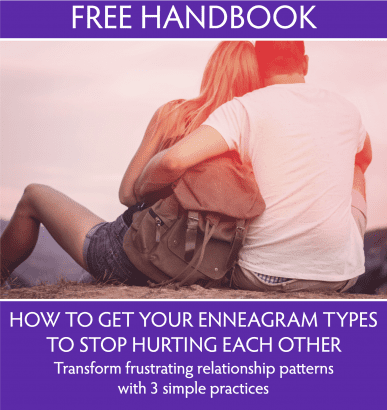What if you’ve been missing the memo that your relationship has been trying to broadcast to you? What if all those annoying things about your dynamics and your partner are actually here to help you grow?
In this article, we’ll look at how modern relationships present us with new developmental opportunities, ones than most people in the past never “got” to grapple with.
We will also look at how your Enneagram type contributes to your dissatisfaction in relationship, and how you can start to steer into more fruitful and satisfying territory instead.
I will illustrate some of what’s possible with a story about my own relationship distress, and also offer you a 5-Step inquiry exercise to reflect on yours.
WHEREFORE ART THOU, LOVE?
 It is common to feel let down in relationship. Our primary bonds mean so much to us, even when we don’t feel warm toward our partners. When we don’t feel content in our love lives, life itself lacks luster.
It is common to feel let down in relationship. Our primary bonds mean so much to us, even when we don’t feel warm toward our partners. When we don’t feel content in our love lives, life itself lacks luster.
For the last several decades in the Western World we’ve asked more of our partnerships than ever before. More than an economic, procreative or societal unit, a relationship is now looked to to fulfill us emotionally, romantically, and spiritually. A lot of relationships don’t measure up to these expectations, but we keep seeking the promise anew.
Theories abound about why marriages and partnerships fall apart so often in the developed world.
- Is the rise of secular values and self-interest?
- Is it the liberation of women personally and economically?
- Is it Hollywood stuffing us with unrealistic expectations?
I’m sure there are many factors worth studying, but today I’d like to address this conundrum from a cultural and personal development perspective.
ARE WE REALLY FAILING?
With higher expectations in love relationships, we’ve been experiencing higher rates of what feels like failure. Some suggest that our current expectations are unrealistic and that we need to let go of idealizing our primary relationships— they can’t be the place we look to for all our fulfillment. It’s too much to put on our partner.
I agree with this point in general, but I don’t want to dismiss or overlook the deep longing arising in our hearts that is calling us to something more. Call me romantic, but I believe this sacred yearning in us is of the same magic stuff that inspires us to create art, seek the divine, and fuel courageous social movements.
I don’t think that having too high of expectations is the problem.
I think the trouble comes from not knowing how to work with ourselves when the temperature turns up in relationship.
I used to be a classroom teacher. An old-school way of thinking about students was to see students as “good students” or not, and “well-behaved” or not. A more progressive teacher when considering a student who is struggling now thinks in terms like:
“How do I make this content relevant to my students where they are?” and
“What kinds of additional support or other modes of learning might help my students ‘get it’ better?”
I’ve been a Mental Health Counselor for many years. Not so many years ago in psychology (and medicine in general) it was common to hear that a particular patient described as “resistant to treatment.” The problem was attributed to the patient, which is a commonly made cognitive error in my opinion. We could also see it this way: the practitioner didn’t yet have the right tools or understanding to know how to help this person.
In life, as in relationships, it can be hard to see that when our ordinary means are failing, that the problem is not simply the other’s poor response. When we don’t understand what’s needed to ease distress, or to restore health, it is a common temptation (especially after awhile of trying) to blame the other. After all, we tried hard and had good intentions. Is this familiar at all?
It’s true that we don’t know what we don’t know. But let’s not give up on the heart’s deep desires simply because of our ignorance or our failure of imagination.
LOVE’S DEVELOPMENT
As we fall in love, we naively expect that the state of mutual idealization will continue.
 When we remain in relationship beyond that strongest surge of hormonal and neurochemical intoxication, we are presented with the opportunity to see our beloved in a more balanced and sophisticated way, assessing whether we are well-suited in terms of values, companionship, etc.
When we remain in relationship beyond that strongest surge of hormonal and neurochemical intoxication, we are presented with the opportunity to see our beloved in a more balanced and sophisticated way, assessing whether we are well-suited in terms of values, companionship, etc.
If we still find the other satisfying enough, and choose to continue into the future in an emotionally committed relationship, we are presented with new opportunities for bonding and growth.
Some people find this happens naturally in many areas. In relatively healthy couple relationships, we “grow each other up” in lots of ways, as we witness and support each other through life’s challenges.
And even in such “good-enough,” “solid-enough” relationships, there are often lots of places where we start to feel stagnant or stuck. We learn to avoid certain hot spots, or to hold back certain needs. We naturally adjust to one another to try to keep our most important bond stable.
In this process, we also create the shadow side of stability. We start to share fewer of our true feelings with each other. We tamp down our passions so they don’t threaten things. We show up less in sex, or maybe we just have less sex. We talk about managerial things because they are easier to address than our resentments, fears and insecurities.
When this shadow side goes unaddressed for too long, pressure mounts and we start to feel bitter or cold, check out, have affairs or lash out in distress. And this is not always dramatic or right on the surface.
It is scary to bring forward our truth or our needs to our partner- not only because we’re afraid of disrupting the status-quo, but because we are profoundly afraid of rejection.
As David Schnarch PhD, Couples and Sex Therapist names, “We don’t like f*cking with our support system.” It feels frightening to show up raw and real in the relationship that we see as the foundation in our lives.
Whether you see this common shift in long-term relationships as simply the natural mellowing of passion, the hypnotizing comfort of a domestic life, or the death-knell of romance, you likely have seen this phenomenon in yourself and others. It seems like it’s what inevitably happens in most relationships after awhile, right?
Right. But that’s because we don’t understand or know how to respond to what’s arising in us.
MISINTERPRETING THE SIGNS
Pop psychology will tell you that after infatuation fades, the best you can expect from a committed relationship is a comfortable companionship sometimes punctuated with some nice sex or occasional adventures together. And that this can be a nice basket to relax into once you let go of your fantasies.
Except for when it’s not.

Except for when we hide our needs or withhold our affection.
Except for when we constantly irritate each other and don’t know how to stop.
Except for when we feel taken for granted or not attended to.
Except for when we lose curiosity about each other or assume ill intention.
Except for when we feel lonely with our partner in the same room.
Except for when we don’t know how to address our deeper differences.
Except for when we feel helpless about how to reconnect.
Except for when we feel these things and think we have to pretend that we don’t.
I’d say that pop psychology represents something accurately in its picture of passion’s fading. It inadvertently admits how we stuff our vitality in exchange for the sense of comfort and stability that we seek in relationship.
What this typical portrayal doesn’t address is 3-fold:
- It doesn’t address how many couples do not find this a satisfying plateau for long.
- It doesn’t acknowledge the next step that’s possible in relationship development.
- It doesn’t suggest there are ways to leverage relationship safety toward even more dynamic intimacy and aliveness.
Pop psychology doesn’t really know about “mature love” and its promise of enlivening our hearts and deepening our intimacy.
It’s common when we’re feeling dissatisfied, to wonder:
- Is something missing?
- Is it my fault my partner doesn’t seem into me?
- Is there something wrong with my partner?
- Is our relationship rolling to a stop?
While these questions are natural, they’re not really aimed in the right direction. Disconnection and re-connection in relationship is natural and normal. It’s usually not anyone’s fault in the ordinary sense. It happens in all relationships.
It’s when we don’t know how to find our way back to connection that we start to get worried.
YOUR ENNEAGRAM TYPE AS AN OLD-WORLD GUARD
 A lot of the ho-hum or status-quo feelings we have in relationships are related to the fact that our ego-structures are working all the time to keep us within a “safe” or familiar zone.
A lot of the ho-hum or status-quo feelings we have in relationships are related to the fact that our ego-structures are working all the time to keep us within a “safe” or familiar zone.
Our Enneagram types fuel an ongoing stream of instructions that they (at some level) think are helping us in relationship, like:
- “Don’t say what you think; she’ll get offended.”
- “Be confident- no one likes an anxious mess.”
- “Better test to see if he really means it.”
- “Sound loving right now so he won’t leave you.”
- “That’s unacceptable! Don’t let her know about that.”
- “Let’s not focus on that. Look on the bright side!”
- “Do it yourself. Don’t ask for help.”
- “Don’t be weak. Approach this thing head-on.”
- “Show him even more ways he’s great. That’ll work.”
As we follow these types of instructions, we expect that things should turn out well for us. The “adaptive strategies” of our Enneagram points are baffled when we don’t end up feeling more loved, secure, or OK after following their advice. It can take a lot of practice to learn to doubt these directives. They seem so authoritative and convincing, even when we’ve seen them not work out time after time. We don’t assume that they can be a significant part of the problem.
Not only are our Enneagram types enforcers of the old (supposedly) safe regime, they also function as a mirage. By their nature, they obscure who we really are and what life is about. They can feel a bit threatened when we are in touch with our essential self, like they’ll lose their pole position.
When our enneatype is in the drivers seat, it is natural that we “fall asleep” to who we really are and live only from a portion of ourselves. This creates dullness in ourselves and in our relationships. It is in unmasking the unconscious working of our types that the Enneagram can offer real renewal in our relationships.
Until you can see how your type is undermining your satisfaction, this cycle will repeat and repeat and repeat. Ultimately, developmentally, this is a good thing- it’s aimed at helping you to wake up to your no longer relevant operating instructions in service of finding a better way.
And ultimately your type is a good thing too— it has supported you to develop to the place where you can now check things out for yourself. Trouble is, it thinks it still knows best, and when it’s running the ship, it will lead you astray more often than not. This is why we need to build a real muscle of mindfulness around these patterns— so we can chart and steer our own craft through the elements in an artful way.
ENNEAGRAM DISCOMFORTS AND FEARS
So here are some coordinates to sync up with your map to help you see how your Enneagram type contributes to disconnection in relationship.
For each type, I’ve listed two “repeating surface relational discomforts,” or frequent emotional experiences each type recycles in relationship.
The “deeper fear” names the often unconscious false belief that keeps us running in the hamster wheel of identifying with our ego/type.
Repeating Surface Relational Discomfort
Type 1 Feel judgmental, resentful
Type 2 Feel unappreciated, unmet
Type 3 Feel thwarted, disapproved of
Type 4 Feel lacking, abandoned
Type 5 Feel depleted, intruded upon
Type 6 Feel mistrustful, unsupported
Type 7 Feel trapped, deprived
Type 8 Feel blamed, manipulated
Type 9 Feel pressured, invisible
Deeper Fear (Underground FALSE Belief)
Type 1 I’m wrong/bad
Type 2 I’m not intrinsically loved
Type 3 I’m not valued for who I am
Type 4 I’m defective/broken
Type 5 I don’t have resources
Type 6 I don’t have support/ground
Type 7 I don’t have vitality
Type 8 I’m tainted/wronged
Type 9 I don’t matter
Ugh. These uncomfortable feelings are certainly not fun to feel into, and the deeper fears we usually don’t want to even to entertain. Just like we don’t like to come close to our insecurities and needs in relationships. So our types keep trying to muddle through for us without ground, guidance or presence from the part of us who can really help. So we keep feeling the discomfort and trying to address it or defend against it so we don’t have to look at the fear.
This doesn’t feel like either sweet romance or comfortable coexistence anymore. This feels seriously dangerous.
No wonder we become dissatisfied in relationship and annoying to our partners rather than deal with this layer. And assuming they’re caught in their own version of this existential fear-avoidance dance, no wonder they’re dissatisfied and annoying too!
No wonder so many of us don’t see (or don’t want to see) the threshold that awaits us when love bumps up against the tricky inner territory of our hearts and our psyches. And we really don’t want our partners to see what might be there.
No wonder we feel it’s better to stuff it or blame each other rather than face that dragon.
THE DEVELOPMENT OF MATURE LOVE
The developmental opportunity that awaits us after we’ve established some safety and trust in relationship is that of increased emotional intimacy. I’ll call it “mature love” for short.
This is what I imagine the poet Rilke was referring to when he wrote:
“For one human being to love another human being: that is perhaps the most difficult task that has been given to us, the ultimate, the final problem and proof, the work for which all other work is merely preparation.”
I don’t think Rilke was talking about “love” here as new romance or domestic cohabitation. He was acknowledging the profound challenge of authentic relating over time.
By emotional intimacy, I do not mean anything sentimental or squishy. Emotional intimacy is what can grow when we figure out how to face ourselves in the presence of another. It can emerge when we care more about the truth than our old stories.
In most cases it is fostered through risk-taking. Couples therapist Terry Real says,
“One of the paradoxes of healthy intimacy is that sustained connection rests on our capacity to put our relationship at risk from time to time. Slaves do not make loving partners.”
 When I stand up in the face of my deeper fears to meet what’s there in my own experience and to allow myself to be witnessed in it, an aliveness can return. When I can do this knowing there’s no guarantee of approval from the other, I am liberated a bit from my “safety” regime, and I start to feel fresh air rolling back in. My self-confrontation unlocks my inner prison cell.
When I stand up in the face of my deeper fears to meet what’s there in my own experience and to allow myself to be witnessed in it, an aliveness can return. When I can do this knowing there’s no guarantee of approval from the other, I am liberated a bit from my “safety” regime, and I start to feel fresh air rolling back in. My self-confrontation unlocks my inner prison cell.
It is extremely hard to make the choice to bravely face our fears when we are primarily identified with our Enneagram types. After all, they are formed in large part to keep us away from these kinds of experiences and confrontations. Why would they let us walk into them willingly?
As long as we follow the rules of our types, trying to keep playing it safe, we will stay scared. We will not enter the cave to investigate the dragon.
And this lock-down is an important reason underneath why we feel disconnected, anxious, unsatisfied and deadened in relationship. Our souls are wanting more, and our egos, in their risk-management mandate, keep us locked away from ourselves and each other.
THE DANCE WITH MY OWN DRAGON
I’m totally interested in these principles and have been studying them for years, and, the other night, there I found myself in the grip of them again. So right now I’ll practice a little intimacy with you and share the story of a recent go-round I had.
My husband and I both orient from type Nine on the Enneagram. Thus, we get a double dose of our discomforts and our fears (as well as our strengths and gifts). My dominant instinct (subtype) is sexual, my husband’s is self-preservation.
Recently, after a long stretch of busy but less-than-heartfelt existence, my instinctual need for one-to-one contact started to get cranky. Historically, when we get to a point like this, our pattern looks something like this: I avoid bringing the need to him for fear of repeating our painful cycle. After awhile, I can’t hold back, I reach out in my need, battling with my fear of not mattering to him. This triggers his inner dragon: the fear of not being what I need and of not knowing what to do in the moment. His survival safety manual steers him to shut down and get more distant to deal with the discomfort— which adds to my distress. His “freeze” increases my feeling of need for contact and increases my fear that I don’t matter to him. It’s torturous for both of us.
And, yes, patterns of relationship distress do happen to people who love each other and who are self-aware. It happens to coaches, doctors, spiritual leaders, psychologists, professors and everyone else we project competence or wisdom onto.
So, we experience this cycle, even after years of working with it. But, we can now enter into it with more strategy, courage, grace, faith and presence than we used to be able to. This is possible because our underlying fears, our dragons, have lost a significant amount of their power through our repetition and devotion, and we have more sense how to enter the cave in a way that will disarm and relieve us both.
 Because I’ve entered the ominous cave so many times before, I’ve developed more resilience (and skill) in the process. It’s as though there’s no real choice but to be brave in the face of my fears of rejection and not mattering to him— because where else is there to go, really? I could try to shrink away from the cave, but that ends up making it scarier and more oppressive.
Because I’ve entered the ominous cave so many times before, I’ve developed more resilience (and skill) in the process. It’s as though there’s no real choice but to be brave in the face of my fears of rejection and not mattering to him— because where else is there to go, really? I could try to shrink away from the cave, but that ends up making it scarier and more oppressive.
So the other night, while I was scared, crying and trying to articulate what I needed, at a certain point, I felt able to act from a different aspect of myself than the unrequited and lonely one. I put my hand on his heart and put his on mine. From there we found our way to saying how we were sorry we disconnect in this way, that we each know it’s hard to live with the other given our differences, and to feel the possibility of opening to each other right then and there.
Getting to that moment was a relief, and the sense of reconnection and relief have continued, as well as our renewed intention to prevent that disconnection from getting so gaping again. I don’t believe we could have gotten to that redemptive moment without the workouts we’d done in the past. Because I have trained myself not to run away, or act out, or give in to despair when we’re in our hard place, the shift was able to occur. My brave self threw my scared self a life-line.
It’s like I have to be real with my vulnerability until something even more real can arrive. When either of us has the bandwidth to show up and be present in the face of our deep discomfort and fear, we’ve illuminated the cave. With light in the darkness, we can figure out what’s possible from there.
THE COURAGE TO BE REAL
What I’m describing here is the brave work that leads to a more mature love. It’s what so many couples steer clear of in long-term relationship if they can. This widespread avoidance (which can look many different ways depending on our types, subtypes, conditioning, culture, etc.) is why we continue to believe the cultural story that intimacy fizzles with time, so we should just get used to the hum-drum life of committed relationship.
I don’t claim to have arrived at mature love, but I know I’m developing more capacity to stand in myself in a way that shines a light in the darkness. I feel the call to grow in this direction for my sake, for my partner’s sake, for humanity’s sake.
The emotional payoff for this is distinctly rewarding. I don’t need to idealize my partner to feel affirmed. I don’t need to hide the unrefined parts of myself so that he won’t reject me. Like in the story The Velveteen Rabbit, we’ve moved through the feverish despair and life-and-death-ness of this difficulty together, and so we have become more real to ourselves and one another.
The honesty of this kind of love has a depth and vulnerability that penetrates our hearts and frees us from the ways we’ve told ourselves we have to be in order to be loved or worthy or of value. And yes, we will look and feel threadbare or lumpy sometimes in the process of growing toward it. A bonus prize of “mature love” is that it softens our type structures, as we feel into our intrinsic value and connection beyond our fears.
I don’t know how I would have come so far on this journey without the mirror that the Enneagram has been for me. What else can cut through our deep-seated beliefs that our worldview is built on with such clarity and leverage? There are so many wonderful insights and practices in the world to support our development, but the Enneagram continues to impress me with how it penetrates my “stuff” and illuminates my soul. It comes right up to the motherlode, and if we can learn to tolerate its revelations long enough, our illusions start to melt away as the sunlight of life comes through and touches us.
WHAT’S YOUR RELATIONSHIP ASKING OF YOU?
I want to offer you an invitation to reflect on how your relationship might be encouraging you to develop.
Below are five steps to explore a layer of this territory to help you consider new possible ways of working with your challenging patterns.
Inquiry Practice: Mining Your Discomfort
- Consider a pattern in a significant relationship that is unsatisfying. Notice what you don’t like about it — how you experience this on a sensory level, an emotional level, and a mental level.
- As you take a few slow breaths, sense into what particularly it triggers in you. What kind of discomfort comes up? Which fears about yourself? What image about yourself does it confront? See if you can go further than you usually do in admitting what’s under there. Resist the temptation to focus on what seems wrong about the other’s behavior.
- See whether it’s possible to open your heart to yourself about this. It is difficult for everyone to host aversive emotions. You may want to sense your feet on the ground and put a hand on your heart to feel the support and contact in a concrete way.
- See whether it’s possible to be curious about this discomfort. What might this discomfort be trying to show you? What if it wants to teach you something? It may be shining a light on fears related to false beliefs or old wounds that want to heal.
- Ask the discomfort what it needs from you right now? Perhaps you can offer it compassion, touch, presence, words of understanding or reassurance.
If this is not straightforward for you, that’s normal. It can be challenging to penetrate this level at first glance. And of course it’s also not always self-evident what to do next after we’ve opened it up. Be kind to yourself as you explore. This isn’t “Operation Storm the Cave.” This takes courage, care, groundedness and loving-kindness. Fostering these qualities create fertile soil for mature love to take root.
Here’s to your brave and beautiful soul coming more and more to into the light!
In the comments below, I would love to hear about your learnings on this theme,
and whether you’d name the common discomforts and deeper fears of your types differently than I have.







11 Responses
Great post, Sarah, and so timely for me. I was just about to ask how to do an inquiry. I can see how the same principles apply to other difficult situations besides those in intimate relationships, e.g., by inquiring into the fears one has to face in working with difficult clients.
Thanks for your comment, John. I’m glad it was useful for you. There are lots of approaches to inquiry- I always recommend starting with grounded presence and breath awareness before opening up new territory. You are right that this kind of process is helpful to help us go to uncomfortable places related to any theme.
Great article! The 5 sets of questions at the end have left me in tears and opened up. It feels good to be honest and vulnerable with myself. But to be this vulnerable with my husband will take some more work. Thank you, will work on this.
Thanks Jeanmarie. Yes- please be gentle with yourself when things open up. It can take practice and skill to bring this to our loved ones. It’s good to get used to tolerating it ourselves first when possible.
Fantastic article. I have just qualified as an enneagram practitioner. Loved your article. I wish to wok with the subject of conflict… within the Corporates. This is a new field for me this year.
Do you have any articles on Confluct?
I would love to stay in touch with you.
Hi Pam. I’m pleased you enjoyed the article. Congratulations on becoming an Enneagram practitioner. I do have materials on conflict, but not currently on my blog. Do stay in touch– email me at sarah@ninesight.com.
Thank you for this!
Most welcome! Glad it spoke to you.
Excellent article. Really appreciate the honesty and insights
Thanks Warwick. Would like to hear how the insights play out in your life too…
Hi Sarah, the story of how you and your husband were able to reconnect is helpful and inspiring.